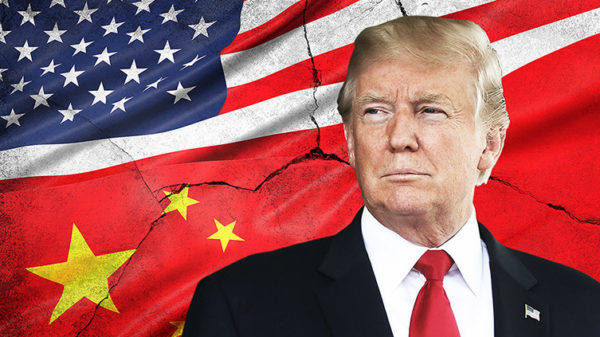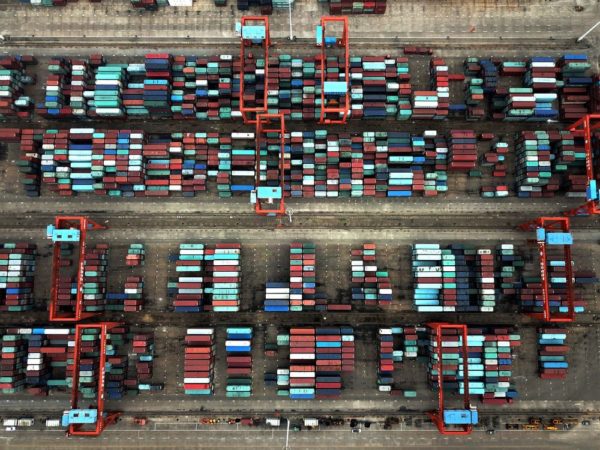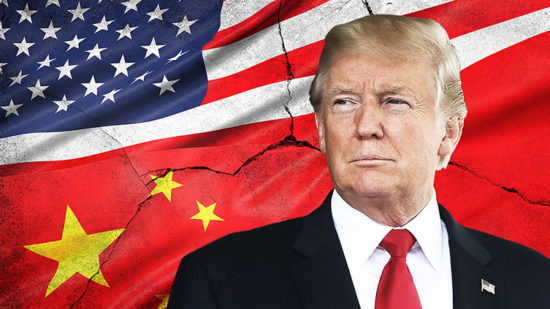Trump’s tariffs raise international tensions and could derail global economic growth
Vincent Kolo, chinaworker.info
The trade war between Washington and Beijing looks set to escalate. The Trump administration is poised to impose tariffs – a punitive tax on imported goods – on a further US$200 billion of Chinese goods. This would be the biggest move so far in the three-month long conflict and follows from the US$50 billion of Chinese goods targeted by Trump in July. Xi Jinping’s regime reciprocated with its own tariffs on an equal amount of US imports. Further escalation could lead to a “protracted, bitter battle,” warns veteran US economist Stephen Roach.
Trump’s claim that trade wars are “easy to win” was mocked by Financial Times columnist Gideon Rachman, who compared this to the wildly inaccurate claims of the British ruling class in August 1914 that the first world war would “all be over by Christmas”.
There is enormous uncertainty even about what strategy the Trump administration is following, if any. Different factions in the government, anti-China hardliners versus more ‘pragmatic’ Wall Street representatives, send out contradictory signals. Sections of the US capitalist class, their Chinese and global counterparts, are holding their breath to see if the conflict can be contained or escalates with potentially grave implications for the world economy, which is already experiencing turbulence especially in ‘emerging markets’.
Washington’s mixed signals are illustrated by the recent proposal from Trump’s Treasury Secretary Steven Mnuchin for a new round of trade talks with China. This glimmer of hope briefly lifted the gloom on Asian and other stock markets in early September. But Trump quickly disassociated himself from Mnuchin’s move, tweeting he was under “no pressure to make a deal”. Previous talks have proved abortive, despite the Chinese side initially offering significant concessions. The result is increased wariness on the part of Xi’s regime fearing that the US side will just keep moving the goalposts if Beijing offers bigger concessions.
While the instability and siege mentality of the Trump administration further complicates matters, as it faces “Russiagate” investigations, numerous other domestic crises, and polls predicting a Democratic “blue wave” that could wipe out Republican control of Congress in the November elections, the roots of today’s trade and economic disputes go much deeper than this, to the fundamental inability of global capitalism to take society and the economy forward.

Imperialist conflict
The more Trump’s trade agenda rolls out the clearer it has become that China is the main target. His administration reached deals with the EU in July and Mexico in August, both of which increase the pressure on Beijing. It’s also clear that this conflict is only partly about trade and is in fact driven by bigger geopolitical and strategic issues as US imperialism seeks to defend its position as the preeminent world power against it’s strongest international rival.
As one Chinese fund manager told The Economist magazine, “The Americans don’t want a deal. They want to screw us.”
Having initially gone into battle over the huge trade imbalance between the US and China, Trump’s spokesmen have shifted the focus to technology and Beijing’s ‘Made in China 2025’ industrial modernisation plan.
“I don’t really believe that the US-China dispute is truly about trade imbalance,” said Stephen Roach at a conference in Hong Kong. “I think it’s more of a strategic clash over innovation and technology – the holy grail of any nation’s economic prosperity.”
Furthermore, US politicians now speak about the “structural issues” with China’s economy. They are increasingly taking aim at China’s state capitalist economic model: its large state sector and more extensive government intervention compared to “normal” free market capitalism. The US and its hungry multinationals, which want to prize open China’s protected state sector, complain that the Chinese approach amounts to “cheating”. Xi, while prepared to offer concessions, will never compromise over this issue which is central to the regime maintaining its dictatorial rule.
Read more ➳ Trump’s trade war draws closer
Trump has claimed his tariffs are working “big time” against China. But this is a mixture of bravado, showing toughness in order to shore up his domestic position, and the president’s poor understanding of the subject.
In fact, the US trade deficit with China and worldwide has actually risen since his first batch of tariffs were introduced. July’s deficit with China (for trade in goods) was a record US$36.8 billion. The total i.e. worldwide US trade deficit also rose to US$50.1 billion – hardly evidence that Trump’s policies are working. The rise in the dollar, a byproduct of Trump’s policies, is the main reason for this because it has made foreign goods cheaper for US consumers.
World’s biggest economies
Capitalist commentators are increasingly alarmed about the potential impact of a full-blown trade war between the world’s two most important economies, which together account for 40 percent of global GDP and 53 percent of global growth. This could ultimately tip the world economy into recession.
It would also enormously frustrate any coordinated international response to a new financial crisis, an eventuality that is not at all excluded. None of the fundamental causes of the previous crisis in 2008 have been addressed. Actually, they have reached even more extreme levels: indebtedness, financial speculation and bubbles. At the same time, as a South China Morning Post editorial recently stated, the policies implemented globally to ‘solve’ the last crisis have resulted in “the greatest wealth transfer in history from the have-nots and have-littles”. Trump’s policies, despite his populist rhetoric, only reinforce this process while injecting much greater instability into US and world politics.
In addition to the tariffs on US$200 billion of Chinese goods that Washington has approved but not yet implemented, Trump has threatened to slap tariffs on a further US$267 billion of Chinese goods, which would mean a “Trump tax” on everything China exports to the US.
The Chinese side retaliated “dollar for dollar” against the first batch of US tariffs in July, but with China importing only US$129 billion in total from the US, compared to the US$505 billion moving in the opposite direction (data for 2017), Beijing will not be able to keep retaliating tit for tat if the conflict escalates. It has other options to exert counter-pressure such as targeting US services, tourism is one obvious example, or taking measures against US-owned multinationals operating in China.
But a recent survey by the American Chamber of Commerce in China showed that three quarters of US companies based there are predicting reduced profits and sales as a result of the tariffs. Rather than target these companies for retaliation, Beijing is trying to woo them with concessions. It is not accidental that no anti-US protests or boycott calls have broken out in China, on similar lines to past protests – largely stage managed by the authorities – against Japan, South Korea and the Philippines.
None of Beijing’s options for retaliation are pain free. That of course is implicit in any tit for tat conflict, where deterrence and the political prestige of the governments involved often outweighs negative economic impacts. Xi’s regime does not want to widen the conflict, in so far as it can decide this, and has therefore taken only minimal countermeasures while at the same time muzzling its own media to prevent overly nationalistic and belligerent outbursts.

China’s economic problems
This reflects deep concerns within China’s ruling elite over the vulnerable state of the economy. These problems predate Trump and his ‘America First’ policies, but the trade war could now make things a lot worse.
China’s debt-driven growth model is losing speed. Discontent is rising as social inequality reaches alarming levels. The government is caught on the horns of a dilemma – to continue its crackdown on debt (to avoid a financial crisis) or revert to debt-financed stimulus (to avoid a sharp slowdown or recession). Its response to the trade war is therefore to try to keep a lid on things and tread a precarious balance in the hope of not “provoking” Trump further while also not appearing weak.
China’s stock market slump – shares have fallen 25 percent since January – is one symptom of mounting economic problems. Total market capitalisation has almost halved since the stock market crash of 2015, from US$10 trillion to 5.7 trillion now. Not only has China lost its position as the world’s second biggest stock market to Japan, but on current valuations its entire stock market is “only worth five Apples” as Bloomberg pointed out recently (US tech giant Apple is worth $1.08 trillion).
Read more ➳ Trump and China: Heading for conflict?
The direct damage to China’s economy from the trade war has been rather limited – so far. Total exports to the US only account for 4 percent of China’s GDP, but this figure hides a much bigger problem. China’s export sector is a crucial link in a vast system of global production chains which source materials and components from across the wider Asia region and send the finished goods to the US and other mature capitalist markets.
The longer a trade war drags on the higher the risk that companies – foreign and Chinese – will relocate to other countries outside the trade war. This is a process that was already underway, especially with lower value exporters shifting from China complaining of “high wages”, to countries like Vietnam, Cambodia and Indonesia, where wages are barely one-third of the level in China. South Korea’s Samsung for example has already announced a cut in smartphone output in China, shifting some production lines to India and Vietnam.
If Trump makes good on his threat to levy tariffs on all Chinese imports this would have a serious impact causing the loss of 5.5 million jobs, according to Haibin Zhu, chief China economist at JPMorgan Chase in Hong Kong.
Warnings of financial crisis
However an even bigger threat could come indirectly, in the form of a chain reaction of collapsing confidence among the capitalists. This is especially regarding massively inflated Chinese financial assets including property, bonds, wealth management products and other exotic financial instruments. These have been pumped up to ludicrous levels as a result of the credit tsunami of the past decade. A similar process has played out in other ‘emerging markets’ such as Turkey, Argentina and South Africa, where once again a crisis is brewing. The capitalists and financial speculators are dumping emerging market assets such as stocks and currencies and fleeing for higher returns in the US.
The dangers were underlined by former central bank boss, Zhou Xiaochuan, who said the US tariffs were “not very significant” in themselves. But he went on to warn, “People may become nervous… Nobody really knows. Suddenly there is a trade war. They may change their mind in terms of stock market investment. This kind of behaviour is much bigger than the real [economic] impact.”
Zhou’s latest warning has to be seen in connection with his headline grabbing comments last year that China could face a so-called ‘Minsky Moment’, or burst financial bubble, as befell the US economy in 2008 and Asia’s ‘miracle economies’ in 1997. Zhou, perhaps more than most, knows that China’s unprecedented debt levels, property and investment bubbles, pose huge risks for the economy.
Most commentators seem to have concluded the trade war is going Trump’s way, but this is short-sighted in the extreme. The US economic upturn of this year may already have peaked while dark clouds are gathering over the world economy, fuelled by the policies of Trump’s government. Both the US and China will lose from this standoff, and unfortunately the working class in both countries will pay the biggest price through business closures, lost jobs and inflation.
Socialists don’t support capitalist ‘free trade’ which is a false label, hiding the exploitation of poorer economies by the most powerful ones. Neither do we support capitalist protectionism, which aims to defend the profits of one set of capitalists against another. The current trade war is yet another wake-up call showing the need to build a socialist alternative internationally to put an end to the toxic system of capitalism.




